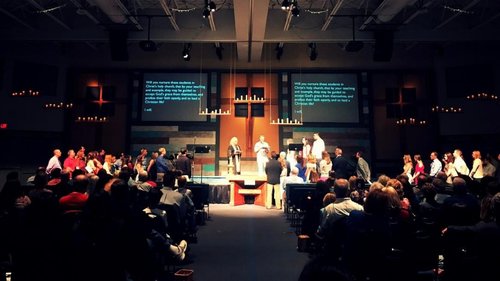
Week 7: The Relevancy of Worship Styles and the Importance of Diverse Worship Expression at Wheatland Salem
After going a few weeks without speaking with anyone from the churches I was observing, this week I found myself in a church interviewing an old friend.
Eight years ago, John Dudich worked in the Student Ministries office at Good Shepherd, and was one of my youth leaders during my eighth grade year. Now, he’s the Worship Director at Wheatland Salem, and I got the chance to talk to him about all of the amazing things they’re doing!
I used to drive by Wheatland Salem every single day on my way school. To me, it was just another church that I saw out of the corner of my eye. I knew nothing about it, knew nothing of its size, its involvement in the community, or its worship practices. But now, because of my research, I will never let it go unnoticed.
Founded in 1860, its rich history and devotion to its congregation has set it apart from other churches in the area. According to John, it has been a “major community player since the beginning”. The congregation includes many families that have been around in Naperville for decades. Some of these people have helped build the city and establish it as it is today. In this church, they pour their time and resources, caring about the community and growing as a congregation.
Wheatland Salem can be characterized as a “Contemporary Church with a Traditional service.” Across their two locations (Naperville and Oswego), they offer three contemporary services and one traditional. I had the chance to observe both the traditional and contemporary services at the Naperville campus.
While much smaller than the contemporary services, the traditional is prominent and intimate. When I had the chance to talk to John about its relevancy, we discussed the idea of preserving the tradition, rather than eradicating it. Many would argue that the traditional form of worship is losing relevancy within our modern contemporary culture, yet they forget that tradition is something that shouldn’t be lost or forgotten. Additionally, research shows that Millennials are gravitating towards traditional worship, so can we really even claim that it is becoming irrelevant within our society?
This question has the power to unravel all of our expectations for what happens on Sunday morning.
What really is relevant? Is relevancy defined on a national level? A local level?
Here, my friends, we reach the very heart of my project.
Week after week, I travel across Naperville trying to answer one simple, yet also so incredibly complex, question:
How is the culture of Naperville affecting what happens in churches on Sunday mornings?
Churches respond in many different ways to this question.
They talk about the relevancy of their music, the constant writing and revision of their liturgy, and the topics discussed in the sermon. All of these are fine examples, yet none of the churches have really steeped themselves into local culture (and for that matter, the culture of their congregation) like Wheatland Salem has.
When I asked John this question, he immediately responded with the idea of getting into the minds of their worshipers. Using language that would appeal to the Naperville mom of 3, or the 40 year-old Naperville entrepreneur. He considers worship not only from his perspective, in all of its wonderful intentions, but also from the perspective of those in the seats.
I think there has been a great disconnect between those two perspectives.
For years, I went to my own church and attended worship thinking things were intended to be one way. Yet, when I met with the worship directors, I realized that things were a bit different. Different in a great way, in a way that made me super excited about my church, but still different.
Worship leaders need to be mindful of the ways the people in the seats think and perceive their actions.
John spoke to this issue with great clarity and depth. Worship, even within the same room, is a different experience for everyone.
However,
Worshipers need to be mindful that what they are perceiving is not always what is intended.
This is a matter of humility and a recognization that things aren’t always as they seem.
What’s so cool about Wheatland Salem, is that they don’t have one way of doing worship. People have the opportunity to express themselves in different ways, and contribute to the service. John oversees 30 or so musicians. Part of role is to talk to them about the way they do worship services. They all get to suggest certain songs or music styles, and all of those suggestions are taken seriously. As a result, the congregation is the driving force behind what happens in the worship service.
This even happens in their sermon series! When I observed, they were in a series called “I have a question!”, which dealt with hard questions that came from members of the congregation.
At Wheatland Salem, the perception of the people in the seats is based on an understanding that they are able to be involved in the worship planning process in some shape or form. This is such a special and sacred thing, something that fills my heart joy and makes me appreciate their worship experiences on a whole new level.
So yes, I will continue to drive by this church every time I pick my siblings up from school or go to Jewel. But now, I will do so with a smile and full heart.

